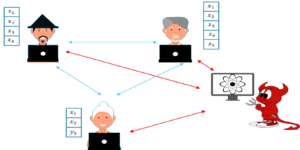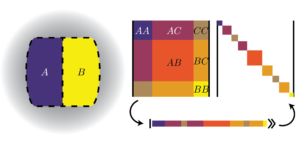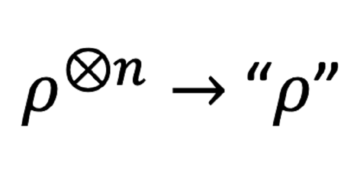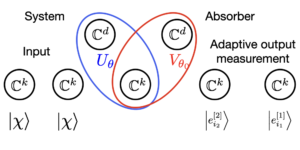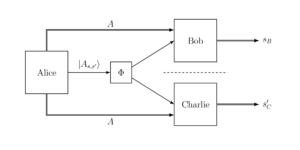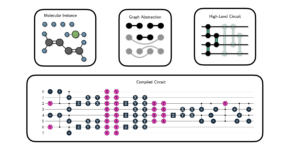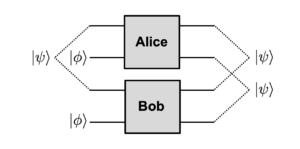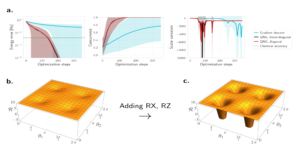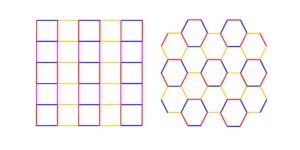Max-Planck-Institut für Quantenoptik, Hans-Kopfermann-Str. 1, 85748 Garching, Germany
Munich Center for Quantum Science and Technology (MCQST), Schellingstr. 4, 80799 München, Germany
Find this paper interesting or want to discuss? Scite or leave a comment on SciRate.
Abstract
Exact solutions in interacting many-body systems are scarce but extremely valuable since they provide insights into the dynamics. Dual-unitary models are examples in one spatial dimension where this is possible. These brick-wall quantum circuits consist of local gates, which remain unitary not only in time, but also when interpreted as evolutions along the spatial directions. However, this setting of unitary dynamics does not directly apply to real-world systems due to their imperfect isolation, and it is thus imperative to consider the impact of noise to dual-unitary dynamics and its exact solvability.
In this work we generalise the ideas of dual-unitarity to obtain exact solutions in noisy quantum circuits, where each unitary gate is substituted by a local quantum channel. Exact solutions are obtained by demanding that the noisy gates yield a valid quantum channel not only in time, but also when interpreted as evolutions along one or both of the spatial directions and possibly backwards in time. This gives rise to new families of models that satisfy different combinations of unitality constraints along the space and time directions. We provide exact solutions for the spatio-temporal correlation functions, spatial correlations after a quantum quench, and the structure of steady states for these families of models. We show that noise unbiased around the dual-unitary family leads to exactly solvable models, even if dual-unitarity is strongly violated. We prove that any channel unital in both space and time directions can be written as an affine combination of a particular class of dual-unitary gates. Finally, we extend the definition of solvable initial states to matrix-product density operators. We completely classify them when their tensor admits a local purification.
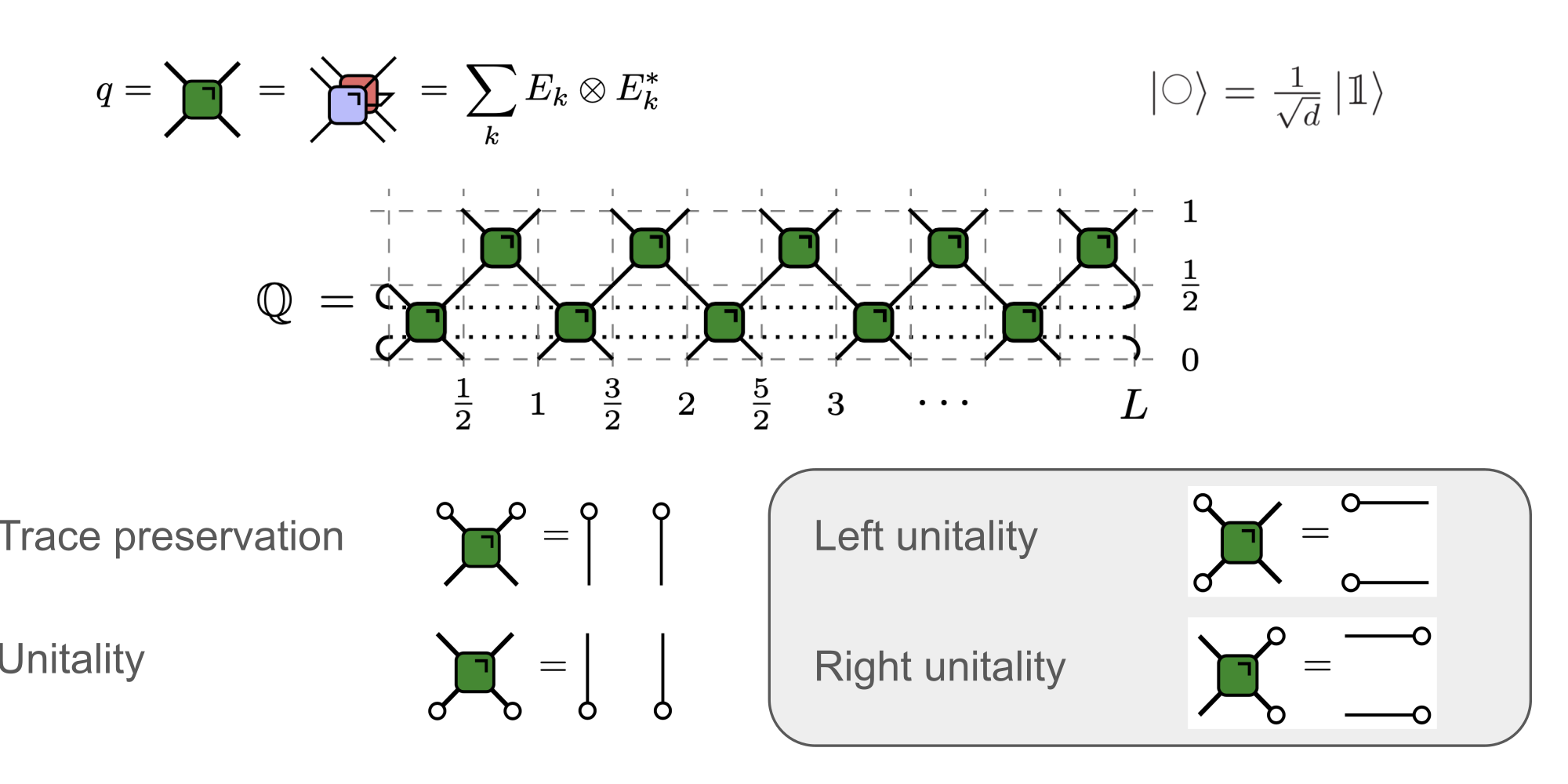
Featured image: In this work, we consider dynamics given by a circuit of local quantum channels. These channels may have additional sideways unitality conditions, which enable exact calculations.
Popular summary
In our work, we generalize one such example –dual-unitary circuits– to systems beyond unitary dynamics, called space-time channels. Here coupling with the environment results in quantum dynamics consisting of local quantum channels, that is, open-system evolution. These space-time quantum channels are characterized by the property that the evolution is still physical upon changing the roles of space and time, exactly as in the case of dual-unitary circuits. This property defines different rich families of models with tractable dynamics.
Our work opens new doors to exactly solvable open quantum circuits. As quantum evolution, simulation, or computation is never entirely isolated from the environment this knowledge is much needed. Moreover, our work also explains why the signature of dual-unitarity (vanishing correlations inside the light cone), which was already witnessed in the experiment, is preserved under typical noise.
► BibTeX data
► References
[1] Adam Nahum, Jonathan Ruhman, Sagar Vijay, and Jeongwan Haah. ``Quantum entanglement growth under random unitary dynamics''. Phys. Rev. X 7, 031016 (2017).
https://doi.org/10.1103/PhysRevX.7.031016
[2] Adam Nahum, Sagar Vijay, and Jeongwan Haah. ``Operator spreading in random unitary circuits''. Phys. Rev. X 8, 021014 (2018).
https://doi.org/10.1103/PhysRevX.8.02101
[3] C. W. von Keyserlingk, Tibor Rakovszky, Frank Pollmann, and S. L. Sondhi. ``Operator hydrodynamics, OTOCs, and entanglement growth in systems without conservation laws''. Phys. Rev. X 8, 021013 (2018).
https://doi.org/10.1103/PhysRevX.8.021013
[4] Tibor Rakovszky, Frank Pollmann, and C. W. von Keyserlingk. ``Sub-ballistic growth of Rényi entropies due to diffusion''. Phys. Rev. Lett. 122, 250602 (2019).
https://doi.org/10.1103/PhysRevLett.122.250602
[5] Amos Chan, Andrea De Luca, and J. T. Chalker. ``Solution of a minimal model for many-body quantum chaos''. Phys. Rev. X 8, 041019 (2018).
https://doi.org/10.1103/PhysRevX.8.041019
[6] S. J. Garratt and J. T. Chalker. ``Local pairing of Feynman histories in many-body Floquet models''. Phys. Rev. X 11, 021051 (2021).
https://doi.org/10.1103/PhysRevX.11.021051
[7] Tomaž Prosen. ``Third quantization: a general method to solve master equations for quadratic open Fermi systems''. New Journal of Physics 10, 043026 (2008).
https://doi.org/10.1088/1367-2630/10/4/043026
[8] Matthieu Vanicat, Lenart Zadnik, and Tomaž Prosen. ``Integrable trotterization: Local conservation laws and boundary driving''. Phys. Rev. Lett. 121, 030606 (2018).
https://doi.org/10.1103/PhysRevLett.121.030606
[9] Lucas Sá, Pedro Ribeiro, and Tomaž Prosen. ``Integrable nonunitary open quantum circuits''. Phys. Rev. B 103, 115132 (2021).
https://doi.org/10.1103/PhysRevB.103.115132
[10] Lei Su and Ivar Martin. ``Integrable nonunitary quantum circuits''. Phys. Rev. B 106, 134312 (2022).
https://doi.org/10.1103/PhysRevB.106.134312
[11] Lucas Sá, Pedro Ribeiro, Tankut Can, and Tomaž Prosen. ``Spectral transitions and universal steady states in random Kraus maps and circuits''. Phys. Rev. B 102, 134310 (2020).
https://doi.org/10.1103/PhysRevB.102.134310
[12] Marko Žnidarič. ``Exact solution for a diffusive nonequilibrium steady state of an open quantum chain''. Journal of Statistical Mechanics: Theory and Experiment 2010, L05002 (2010).
https://doi.org/10.1088/1742-5468/2010/05/l05002
[13] Bruno Bertini, Pavel Kos, and Tomaž Prosen. ``Exact correlation functions for dual-unitary lattice models in 1+1 dimensions''. Phys. Rev. Lett. 123, 210601 (2019).
https://doi.org/10.1103/physrevlett.123.210601
[14] Lorenzo Piroli, Bruno Bertini, J. Ignacio Cirac, and Tomaž Prosen. ``Exact dynamics in dual-unitary quantum circuits''. Phys. Rev. B 101, 094304 (2020).
https://doi.org/10.1103/physrevb.101.094304
[15] Pavel Kos, Bruno Bertini, and Tomaž Prosen. ``Correlations in perturbed dual-unitary circuits: Efficient path-integral formula''. Phys. Rev. X 11, 011022 (2021).
https://doi.org/10.1103/physrevx.11.011022
[16] Bruno Bertini, Pavel Kos, and Tomaž Prosen. ``Exact spectral form factor in a minimal model of many-body quantum chaos''. Phys. Rev. Lett. 121, 264101 (2018).
https://doi.org/10.1103/physrevlett.121.264101
[17] Bruno Bertini, Pavel Kos, and Tomaž Prosen. ``Random matrix spectral form factor of dual-unitary quantum circuits''. Communications in Mathematical Physics (2021).
https://doi.org/10.1007/s00220-021-04139-2
[18] Bruno Bertini, Pavel Kos, and Tomaž Prosen. ``Entanglement spreading in a minimal model of maximal many-body quantum chaos''. Phys. Rev. X 9, 021033 (2019).
https://doi.org/10.1103/physrevx.9.021033
[19] Sarang Gopalakrishnan and Austen Lamacraft. ``Unitary circuits of finite depth and infinite width from quantum channels''. Phys. Rev. B 100, 064309 (2019).
https://doi.org/10.1103/physrevb.100.064309
[20] Pieter W. Claeys and Austen Lamacraft. ``Maximum velocity quantum circuits''. Phys. Rev. Res. 2, 033032 (2020).
https://doi.org/10.1103/physrevresearch.2.033032
[21] Bruno Bertini and Lorenzo Piroli. ``Scrambling in random unitary circuits: Exact results''. Phys. Rev. B 102, 064305 (2020).
https://doi.org/10.1103/physrevb.102.064305
[22] Bruno Bertini, Pavel Kos, and Tomaž Prosen. ``Operator Entanglement in Local Quantum Circuits I: Chaotic Dual-Unitary Circuits''. SciPost Phys. 8, 67 (2020).
https://doi.org/10.21468/SciPostPhys.8.4.067
[23] Suhail Ahmad Rather, S. Aravinda, and Arul Lakshminarayan. ``Creating ensembles of dual unitary and maximally entangling quantum evolutions''. Phys. Rev. Lett. 125, 070501 (2020).
https://doi.org/10.1103/PhysRevLett.125.070501
[24] Boris Gutkin, Petr Braun, Maram Akila, Daniel Waltner, and Thomas Guhr. ``Exact local correlations in kicked chains''. Phys. Rev. B 102, 174307 (2020).
https://doi.org/10.1103/PhysRevB.102.174307
[25] Pieter W. Claeys and Austen Lamacraft. ``Ergodic and nonergodic dual-unitary quantum circuits with arbitrary local Hilbert space dimension''. Phys. Rev. Lett. 126, 100603 (2021).
https://doi.org/10.1103/physrevlett.126.100603
[26] S. Aravinda, Suhail Ahmad Rather, and Arul Lakshminarayan. ``From dual-unitary to quantum Bernoulli circuits: Role of the entangling power in constructing a quantum ergodic hierarchy''. Phys. Rev. Research 3, 043034 (2021).
https://doi.org/10.1103/PhysRevResearch.3.043034
[27] Tomaž Prosen. ``Many-body quantum chaos and dual-unitarity round-a-face''. Chaos: An Interdisciplinary Journal of Nonlinear Science 31, 093101 (2021).
https://doi.org/10.1063/5.0056970
[28] Márton Borsi and Balázs Pozsgay. ``Construction and the ergodicity properties of dual unitary quantum circuits''. Phys. Rev. B 106, 014302 (2022).
https://doi.org/10.1103/PhysRevB.106.014302
[29] Wen Wei Ho and Soonwon Choi. ``Exact emergent quantum state designs from quantum chaotic dynamics''. Phys. Rev. Lett. 128, 060601 (2022).
https://doi.org/10.1103/PhysRevLett.128.060601
[30] Pieter W Claeys and Austen Lamacraft. ``Emergent quantum state designs and biunitarity in dual-unitary circuit dynamics''. Quantum 6, 738 (2022).
https://doi.org/10.22331/q-2022-06-15-738
[31] Matteo Ippoliti and Wen Wei Ho. ``Dynamical purification and the emergence of quantum state designs from the projected ensemble'' (2022). arXiv:2204.13657.
arXiv:2204.13657
[32] Felix Fritzsch and Tomaž Prosen. ``Eigenstate thermalization in dual-unitary quantum circuits: Asymptotics of spectral functions''. Phys. Rev. E 103, 062133 (2021).
https://doi.org/10.1103/PhysRevE.103.062133
[33] Alessio Lerose, Michael Sonner, and Dmitry A. Abanin. ``Influence matrix approach to many-body Floquet dynamics''. Phys. Rev. X 11, 021040 (2021).
https://doi.org/10.1103/PhysRevX.11.021040
[34] Ryotaro Suzuki, Kosuke Mitarai, and Keisuke Fujii. ``Computational power of one-and two-dimensional dual-unitary quantum circuits''. Quantum 6, 631 (2022).
https://doi.org/10.22331/q-2022-01-24-631
[35] Cheryne Jonay, Vedika Khemani, and Matteo Ippoliti. ``Triunitary quantum circuits''. Phys. Rev. Research 3, 043046 (2021).
https://doi.org/10.1103/PhysRevResearch.3.043046
[36] Richard M. Milbradt, Lisa Scheller, Christopher Aßmus, and Christian B. Mendl. ``Ternary unitary quantum lattice models and circuits in $2+1$ dimensions''. Phys. Rev. Lett. 130, 090601 (2023).
https://doi.org/10.1103/PhysRevLett.130.090601
[37] Matteo Ippoliti and Vedika Khemani. ``Postselection-free entanglement dynamics via spacetime duality''. Phys. Rev. Lett. 126, 060501 (2021).
https://doi.org/10.1103/PhysRevLett.126.060501
[38] Matteo Ippoliti, Tibor Rakovszky, and Vedika Khemani. ``Fractal, logarithmic, and volume-law entangled nonthermal steady states via spacetime duality''. Phys. Rev. X 12, 011045 (2022).
https://doi.org/10.1103/PhysRevX.12.011045
[39] Tsung-Cheng Lu and Tarun Grover. ``Spacetime duality between localization transitions and measurement-induced transitions''. PRX Quantum 2, 040319 (2021).
https://doi.org/10.1103/PRXQuantum.2.040319
[40] Eli Chertkov, Justin Bohnet, David Francois, John Gaebler, Dan Gresh, Aaron Hankin, Kenny Lee, David Hayes, Brian Neyenhuis, Russell Stutz, et al. ``Holographic dynamics simulations with a trapped-ion quantum computer''. Nature Physics 18, 1074–1079 (2022).
https://doi.org/10.1038/s41567-022-01689-7
[41] Xiao Mi, Pedram Roushan, Chris Quintana, Salvatore Mandrà, Jeffrey Marshall, Charles Neill, Frank Arute, Kunal Arya, Juan Atalaya, Ryan Babbush, Joseph C. Bardin, Rami Barends, Joao Basso, Andreas Bengtsson, Sergio Boixo, Alexandre Bourassa, Michael Broughton, Bob B. Buckley, David A. Buell, Brian Burkett, Nicholas Bushnell, Zijun Chen, Benjamin Chiaro, Roberto Collins, William Courtney, Sean Demura, Alan R. Derk, Andrew Dunsworth, Daniel Eppens, Catherine Erickson, Edward Farhi, Austin G. Fowler, Brooks Foxen, Craig Gidney, Marissa Giustina, Jonathan A. Gross, Matthew P. Harrigan, Sean D. Harrington, Jeremy Hilton, Alan Ho, Sabrina Hong, Trent Huang, William J. Huggins, L. B. Ioffe, Sergei V. Isakov, Evan Jeffrey, Zhang Jiang, Cody Jones, Dvir Kafri, Julian Kelly, Seon Kim, Alexei Kitaev, Paul V. Klimov, Alexander N. Korotkov, Fedor Kostritsa, David Landhuis, Pavel Laptev, Erik Lucero, Orion Martin, Jarrod R. McClean, Trevor McCourt, Matt McEwen, Anthony Megrant, Kevin C. Miao, Masoud Mohseni, Shirin Montazeri, Wojciech Mruczkiewicz, Josh Mutus, Ofer Naaman, Matthew Neeley, Michael Newman, Murphy Yuezhen Niu, Thomas E. O'Brien, Alex Opremcak, Eric Ostby, Balint Pato, Andre Petukhov, Nicholas Redd, Nicholas C. Rubin, Daniel Sank, Kevin J. Satzinger, Vladimir Shvarts, Doug Strain, Marco Szalay, Matthew D. Trevithick, Benjamin Villalonga, Theodore White, Z. Jamie Yao, Ping Yeh, Adam Zalcman, Hartmut Neven, Igor Aleiner, Kostyantyn Kechedzhi, Vadim Smelyanskiy, and Yu Chen. ``Information scrambling in quantum circuits''. Science 374, 1479–1483 (2021).
https://doi.org/10.1126/science.abg5029
[42] John Preskill. ``Quantum computing in the NISQ era and beyond''. Quantum 2, 79 (2018).
https://doi.org/10.22331/q-2018-08-06-79
[43] Pavel Kos, Bruno Bertini, and Tomaž Prosen. ``Chaos and ergodicity in extended quantum systems with noisy driving''. Phys. Rev. Lett. 126, 190601 (2021).
https://doi.org/10.1103/PhysRevLett.126.190601
[44] Michael A. Nielsen and Isaac L. Chuang. ``Quantum computation and quantum information: 10th anniversary edition''. Cambridge University Press. (2010).
https://doi.org/10.1017/CBO9780511976667
[45] Ingemar Bengtsson and Karol Życzkowski. ``Geometry of quantum states: An introduction to quantum entanglement''. Cambridge University Press. (2017).
https://doi.org/10.1017/CBO9780511535048
[46] J. Ignacio Cirac, David Pérez-García, Norbert Schuch, and Frank Verstraete. ``Matrix product states and projected entangled pair states: Concepts, symmetries, theorems''. Rev. Mod. Phys. 93, 045003 (2021).
https://doi.org/10.1103/RevModPhys.93.045003
[47] Fernando Pastawski, Beni Yoshida, Daniel Harlow, and John Preskill. ``Holographic quantum error-correcting codes: toy models for the bulk/boundary correspondence''. Journal of High Energy Physics 2015 (2015).
https://doi.org/10.1007/JHEP06(2015)149
[48] Dardo Goyeneche, Daniel Alsina, José I. Latorre, Arnau Riera, and Karol Życzkowski. ``Absolutely maximally entangled states, combinatorial designs, and multiunitary matrices''. Phys. Rev. A 92, 032316 (2015).
https://doi.org/10.1103/PhysRevA.92.032316
[49] John Watrous. ``The theory of quantum information''. Cambridge University Press. (2018).
https://doi.org/10.1017/9781316848142
[50] Mary Beth Ruskai, Stanislaw Szarek, and Elisabeth Werner. ``An analysis of completely-positive trace-preserving maps on $M_2$''. Linear algebra and its applications 347, 159–187 (2002).
https://doi.org/10.1016/S0024-3795(01)00547-X
[51] Christian B. Mendl and Michael M. Wolf. ``Unital quantum channels - Convex structure and revivals of Birkhoff's theorem''. Communications in Mathematical Physics 289, 1057–1086 (2009).
https://doi.org/10.1007/s00220-009-0824-2
[52] LJ Landau and RF Streater. ``On Birkhoff's theorem for doubly stochastic completely positive maps of matrix algebras''. Linear algebra and its applications 193, 107–127 (1993).
https://doi.org/10.1016/0024-3795(93)90274-R
[53] Barbara Kraus and J. Ignacio Cirac. ``Optimal creation of entanglement using a two-qubit gate''. Physical Review A 63, 062309 (2001).
https://doi.org/10.1103/PhysRevA.63.062309
[54] Lev Vidmar and Marcos Rigol. ``Generalized gibbs ensemble in integrable lattice models''. Journal of Statistical Mechanics: Theory and Experiment 2016, 064007 (2016).
https://doi.org/10.1088/1742-5468/2016/06/064007
[55] Frank Verstraete, Juan J Garcia-Ripoll, and Juan Ignacio Cirac. ``Matrix product density operators: Simulation of finite-temperature and dissipative systems''. Physical Review Letters 93, 207204 (2004).
https://doi.org/10.1103/PhysRevLett.93.207204
[56] Gemma De las Cuevas, Norbert Schuch, David Pérez-García, and J. Ignacio Cirac. ``Purifications of multipartite states: limitations and constructive methods''. New Journal of Physics 15, 123021 (2013).
https://doi.org/10.1088/1367-2630/15/12/123021
[57] Gemma De las Cuevas, TS Cubitt, J Ignacio Cirac, MM Wolf, and David Pérez-García. ``Fundamental limitations in the purifications of tensor networks''. Journal of Mathematical Physics 57, 071902 (2016).
https://doi.org/10.1063/1.4954983
[58] Mark Fannes, Bruno Nachtergaele, and Reinhard F Werner. ``Finitely correlated states on quantum spin chains''. Communications in mathematical physics 144, 443–490 (1992).
https://doi.org/10.1007/BF02099178
[59] David Perez-García, Frank Verstraete, Michael M Wolf, and J Ignacio Cirac. ``Matrix product state representations''. Quantum Information and Computation 7, 401–430 (2007).
https://doi.org/10.48550/arXiv.quant-ph/0608197
arXiv:quant-ph/0608197
[60] Mikel Sanz, David Perez-Garcia, Michael M Wolf, and J Ignacio Cirac. ``A quantum version of Wielandt's inequality''. IEEE Transactions on Information Theory 56, 4668–4673 (2010).
https://doi.org/10.1109/TIT.2010.2054552
Cited by
[1] Alessandro Foligno and Bruno Bertini, "Growth of entanglement of generic states under dual-unitary dynamics", arXiv:2208.00030, (2022).
[2] Katja Klobas, Cecilia De Fazio, and Juan P. Garrahan, "Exact "hydrophobicity" in deterministic circuits: dynamical fluctuations in the Floquet-East model", arXiv:2305.07423, (2023).
[3] Richard M. Milbradt, Lisa Scheller, Christopher Aßmus, and Christian B. Mendl, "Ternary Unitary Quantum Lattice Models and Circuits in 2 +1 Dimensions", Physical Review Letters 130 9, 090601 (2023).
[4] Pieter W. Claeys, Austen Lamacraft, and Jamie Vicary, "From dual-unitary to biunitary: a 2-categorical model for exactly-solvable many-body quantum dynamics", arXiv:2302.07280, (2023).
[5] Michael A. Rampp, Roderich Moessner, and Pieter W. Claeys, "From Dual Unitarity to Generic Quantum Operator Spreading", Physical Review Letters 130 13, 130402 (2023).
The above citations are from SAO/NASA ADS (last updated successfully 2023-05-25 23:36:01). The list may be incomplete as not all publishers provide suitable and complete citation data.
On Crossref's cited-by service no data on citing works was found (last attempt 2023-05-25 23:36:00).
This Paper is published in Quantum under the Creative Commons Attribution 4.0 International (CC BY 4.0) license. Copyright remains with the original copyright holders such as the authors or their institutions.
- SEO Powered Content & PR Distribution. Get Amplified Today.
- PlatoAiStream. Web3 Data Intelligence. Knowledge Amplified. Access Here.
- Minting the Future w Adryenn Ashley. Access Here.
- Buy and Sell Shares in PRE-IPO Companies with PREIPO®. Access Here.
- Source: https://quantum-journal.org/papers/q-2023-05-24-1020/
- :is
- :not
- :where
- ][p
- 1
- 10
- 100
- 102
- 10th
- 11
- 12
- 13
- 14
- 15%
- 17
- 20
- 2001
- 2013
- 2015
- 2016
- 2017
- 2018
- 2019
- 2020
- 2021
- 2022
- 2023
- 22
- 23
- 24
- 26
- 27
- 28
- 30
- 39
- 40
- 49
- 50
- 60
- 67
- 7
- 8
- 9
- a
- Aaron
- above
- ABSTRACT
- access
- Adam
- Additional
- affiliations
- After
- AL
- Alan
- alex
- Alexander
- All
- along
- already
- also
- an
- analysis
- and
- Andrew
- Anniversary
- Anthony
- any
- applications
- Apply
- approach
- ARE
- around
- AS
- aspects
- austin
- author
- authors
- BE
- Benjamin
- between
- Beyond
- bob
- boris
- both
- Break
- Brian
- Bruno
- but
- by
- called
- cambridge
- CAN
- case
- cases
- Catherine
- Center
- chain
- chains
- challenging
- chan
- changing
- Channel
- channels
- Chaos
- characterized
- Charles
- chen
- Chris
- Christopher
- class
- Classify
- Collins
- combination
- combinations
- comment
- Commons
- Communications
- complete
- completely
- complicated
- computation
- computer
- computing
- concepts
- conditions
- CONSERVATION
- Consider
- Consisting
- constraints
- constructing
- constructive
- Convex
- copyright
- Correlation
- Craig
- creation
- crucial
- Daniel
- data
- David
- Defines
- demanding
- Den
- density
- depth
- designs
- different
- Diffusion
- Dimension
- dimensions
- directions
- directly
- discuss
- does
- doors
- doubly
- driving
- due
- dynamics
- e
- E&T
- each
- edition
- Edward
- efficient
- emergence
- enable
- energy
- entirely
- Environment
- equations
- Era
- Ether (ETH)
- Even
- evolution
- evolutions
- evolve
- exactly
- Examining
- example
- examples
- Exhibiting
- experiment
- Explains
- extend
- extremely
- factor
- families
- family
- Finally
- fluctuations
- For
- form
- formula
- found
- from
- functions
- Gates
- General
- given
- gives
- gross
- Growth
- Hard
- harvard
- Have
- here
- hierarchy
- High
- Hilton
- holders
- Hong
- How
- However
- HTTPS
- huang
- i
- ideas
- IEEE
- if
- image
- Impact
- imperative
- in
- Inequality
- information
- initial
- insights
- institutions
- interacting
- interesting
- International
- into
- Introduction
- isolated
- isolation
- IT
- ITS
- Jamie
- JavaScript
- John
- journal
- Justin
- Kim
- knowledge
- LAS
- Last
- Laws
- Leads
- Leave
- Lee
- License
- light
- limitations
- List
- local
- Localization
- many
- Maps
- Marco
- mark
- Martin
- master
- mathematical
- Matrix
- matthew
- max-width
- May..
- mcclean
- mechanics
- method
- methods
- Michael
- minimal
- model
- models
- Month
- Moreover
- most
- much
- Nature
- needed
- networks
- never
- New
- no
- Noise
- obtain
- obtained
- of
- on
- ONE
- only
- open
- opens
- operator
- operators
- or
- original
- our
- pair
- pairing
- Paper
- particular
- Paul
- physical
- Physics
- ping
- plato
- Plato Data Intelligence
- PlatoData
- positive
- possible
- possibly
- power
- press
- Problem
- Product
- projected
- properties
- property
- Prove
- provide
- providing
- published
- publisher
- publishers
- quadratic
- Quantum
- Quantum Computer
- quantum entanglement
- quantum information
- quantum systems
- RAMI
- random
- rather
- real world
- references
- relevant
- remain
- remains
- research
- Results
- review
- Ribeiro
- Rich
- Richard
- Rise
- Role
- roles
- Ryan
- s
- Scarce
- Science
- Science and Technology
- Sean
- SEON
- setting
- show
- sideways
- simulation
- since
- So
- solution
- Solutions
- SOLVE
- Space
- Space and Time
- Spatial
- Spectral
- Spin
- spins
- Spreading
- State
- States
- statistical
- steady
- Still
- strongly
- structure
- Successfully
- such
- suitable
- Systems
- Tarun
- Task
- Technology
- that
- The
- their
- Them
- theory
- These
- they
- this
- time
- Title
- to
- toy
- Transactions
- transitions
- Trevor
- typical
- under
- understanding
- Universal
- university
- updated
- upon
- URL
- using
- Valuable
- VeloCity
- version
- via
- violated
- volume
- von
- W
- want
- was
- we
- when
- which
- white
- why
- with
- without
- witnessed
- Wolf
- Work
- works
- written
- X
- year
- Yield
- zephyrnet

